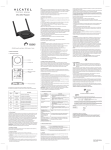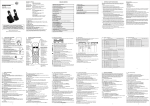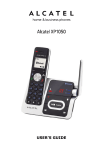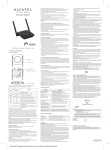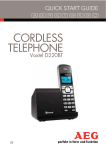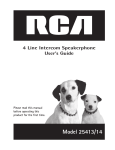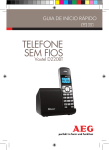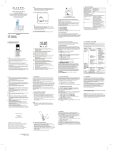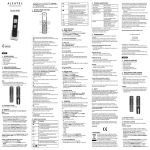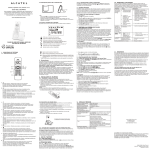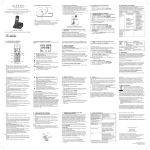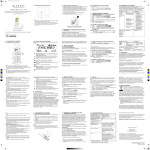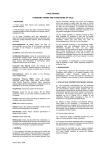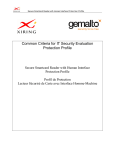Transcript
Office DECT Repeater 1.3.2 Manual registration (optional) You can also follow the instructions below to register the repeater manually. 1. Make sure the repeater is powered off (i.e., the AC power adapter is not connected). 2. Turn on the Repeater mode on the base and then set the base into registration mode. 3. Use the AC adapter to connect the repeater to a power outlet. 4. Press and hold the SETUP button for 5 seconds. The repeater will start the registration to the base. NOTE: The registration mode of the repeater could last for 30 minutes for your convenience. 1.3.3 De-registration / Factory default You can also de-register and then register the repeater again when it cannot hand-off the signal or you want to register it to another base station. Without deregistration, new registration to another telephone base will overwrite previous base record when the registration is completed. Follow the instructions below to de-register the repeater: 1. Disconnect the AC power of repeater. 2. Press and hold the SETUP button, then plug in DC power and hold for 5 seconds. 3. The repeater will be de-registered (reset to factory default). 1.4 Installing the Repeater You need to activate the repeater mode on the base before installing the repeater, and then register the repeater to the base. 1.4.1 Location To get the optimum conditions, the repeater should be placed in a proper location. You can locate the repeater through the LED indicator’s behaviors. www.atlinks.com ATLINKS Europe 22, quai Gallieni – 92150 Suresnes – France 5. ENVIRONMENT This symbol means that your inoperative electronic appliance must be collected separately and not mixed with the household waste. The European Union has implemented a specific collection and recycling system for which producers are responsible. This appliance has been designed and manufactured with high quality materials and components that can be recycled and reused. Electrical and electronic appliances are liable to contain parts that are necessary in order for the system to work properly but which can become a health and environmental hazard if they are not handled or disposed of in the proper way. Consequently, please do not throw out your inoperative appliance with the household waste. If you are the owner of the appliance, you must deposit it at the appropriate local collection point or leave it with the vendor when buying a new appliance. - If you are a professional user, please follow your supplier's instructions. - If the appliance is rented to you or left in your care, please contact your service provider. Keen to preserve the environment, ATLINKS has equipped this appliance with a switching power supply, offering better energy efficiency. The advantages include not only very low electricity consumption, but also a more compact format than the conventional power supply units used by the previous range. The used batteries from your telephone (if it has batteries) must be disposed of in compliance with current environmental protection regulations. Comply with your local regulations. Return your batteries to your reseller or dispose of them at an approved recycling centre. Help us protect the environment in which we live! To get the best operating conditions for the repeater, it is important to place it correctly. Here are a few tips for placing repeaters: Place the repeater as high as possible, but at least 6 feet off the ground. Make sure you have good reception from the base. Make sure the location is close to a corresponding power outlet. Never install electrical cords across a traffic area: they can create a trip hazard or become damaged and create a fire or electrical hazard. Allow at least 35 feet between repeaters (if you are installing repeaters across multiple floors, remember to allow 35 feet vertically as well). Avoid sources of electrical interference, such as hi-fi systems, office equipment or microwave ovens. Avoid heat sources and direct sunlight. Avoid things that can interfere with radio signals, such as metal doors, thick walls, niches and cupboards. 1.4.2 Map the Base coverage area To find the best location for the repeater, you need to determine the base coverage area. Stand near the base and make a call. Walk away from the base with the handset, and make a note where the signal becomes weaker. The optimum location for the repeater is as far from the base as possible while still maintaining a "good" signal, or just inside the location where the signal became weaker. 1. GETTING TO KNOW YOUR REPEATER 1.1 Overview of your Repeater Antenna LED indicator SETUP button Wall mount slots 1.4.3 Test the location To test the location, plug the AC adapter into the repeater, then hold the repeater in the place where you plan to mount it. The LED should remain on and steady, indicating that the repeater has a good signal from the base. © ATLINKS 2011 - Reproduction prohibited. The Manufacturer reserves the right to modify the specifications of its products in order to make technical improvements or comply with new regulations. ALCATEL and ATLINKS are registered trademarks. The Alcatel logo and Alcatel name are trademarks of Alcatel and used under licence by ATLINKS. 1.4.4 Installing the Repeater 1. Hold the repeater in its final location, and mark the center of the top edge. 2. From the edge mark, measure down approximately 1-1/2 inches, and mark the upper screw location, then move down approximately 2-1/2 inches to mark the lower screw location. 3. At the screw locations, use a 3/16ths drill bit to make two pilot holes approximately one inch deep. 4. Place the wall anchor into the pilot holes and tap it gently with a hammer until the anchor is flush with the wall. 5. Insert the mounting screws into the anchor, leaving approximately 1/4 inch space between the screw head and the wall. 6. Put the wall mount slot on the back of the repeater over the screw heads and slide the repeater down into place. IMPORTANT: Be sure the wall material can hold the weight of the repeater. Never install a repeater in damaged or decaying wall material. 7. Connect the repeater to the corresponding power outlet. 2. TROUBLESHOOTING Problems Power socket The SETUP button is used to initiate registration/de-registration process. The LED indicator on the repeater is used to show the link or usage status of the repeater. LED Solutions There is a lot of static when calls handover to the repeater. and/or The LED on the repeater won't stop flashing. Moving the repeater closer to the base. Checking for interference from electronic devices. Making sure the repeater is not too close to metal objects or thick walls. De-registering the repeater and registering it to the base again. Calls will not handover to the repeater. Making sure the repeater is within the base's good signal range. Making sure there is at least 35 feet between repeaters. De-registering the repeater and registering it to the base again. I used to be able to connect to the base, but now I cannot. Making sure the repeater is powered on. De-registering the repeater and registering it to the base again. The repeater continues to flash on and off after registration process had been completed. De-registering the repeater and registering it to the base again. The audio quality is very poor or noisy when receiving a call. The signal connection is very poor. Trying to find another location where the signal to the base is better. Calls lost or audio becomes poor when moving from the base reception range the repeater reception range. You may be moving out of the base or repeater reception range, or are in a blind spot. Moving towards the base or repeater. Description Color Pattern - - Red Long Flash Red/Blue Toggle Blue Triple Flash Registration is completed successfully Blue Steady On Good link to telephone base Purple Steady On Weak link to telephone base No Link to telephone base Powered Off Repeater is not registered Repeater in registration mode Red Steady On Blue Double Flash Repeater is in use with good link to telephone base Purple Double Flash Repeater is in use with weak link to telephone base 1.2 How it works? The DECT repeater lets you extend the coverage area of your telephone system in all directions, including up and down. When registered to the base, the repeater’s coverage area overlaps the coverage area of the base, the base can hand-off calls to the repeater as the user moves from one coverage area to another. When connected to the repeater, the mobile handset operates in the exactly same way as it does when connected to the base, and the hand-off from the base to the repeater can be completely invisible to the end user, even during an active call. Each base supports up to six repeaters, so you can extend the base coverage in all directions, including through floors and ceilings. In addition, the DECT Repeater supports a sequential or "daisy chain" layout to extend coverage in a single direction. Up to two repeaters can be installed in sequence. IMPORTANT: It is possible to roam between the Repeater and the base, however, call handover during conversation is not always guaranteed. 1.3 Setting up your Repeater Before installing the repeater, you need to activate the repeater mode on your telephone system and then register the repeater to the base. 1.3.1 Automatic registration The repeater seeks out the base and automatically registers to that base. 1. Make sure the repeater is powered off (i.e., the AC power adapter is not connected). 2. Turn on the Repeater mode on the base and then set the base into registration mode. (Consult the User Manual that comes with your base station for more information). 3. Use the AC adapter to connect the repeater to a power outlet (Do not use a power outlet controlled by a wall switch). The repeater will register to the telephone base automatically. Note: If the LED continues to flash in red, try registering the repeater again. Use ONLY the power adapter that came with your repeater. A different power adapter may cause an electrical hazard or damage the repeater. The repeater is now registered to this base and is ready to use. You can safely disconnect the power and move the repeater to the selected location, the repeater will stay registered to the base. 3 TECHNICAL SPECIFICATIONS AC Power Adapter Ten Pao - S004LB0600030 / S004LV0600030 input 100-240VAC 50/60Hz 150mA, output 6VDC 300mA Frequency Band 1.88 to 1.9 GHz (bandwidth = 20 MHz) Standards Digital Enhanced Cordless Telecommunication (DECT) 4. SAFETY In the event of an electrical hazard, the mains adapter acts as 230V power isolating device. It should therefore, as a precaution, be installed close to the appliance and be easily accessible. To disconnect the device from the primary power source, the mains adapter must be removed from the 230V AC / 50 Hz socket. If the mains adapter fails, it must be replaced by an identical model. If not connected to the mains power, or if there is a mains power failure, telephones that use cordless handsets will not work. You will then be unable to make or receive calls in the event of an emergency. This is why we recommend that you also keep a conventional telephone – one that doesn’t require a power supply – as a backup. ! Do not use your telephone to notify a gas leak when standing in the vicinity of the leak. It is recommended that you avoid using this device during electrical storms. Do not attempt to open the batteries, as they contain chemical substances. In the event of leakage, avoid contact with the skin, eyes, nose and mouth. In the event of contact, rinse the affected part for about twenty minutes with running water and seek urgent medical attention. Clean the product with absorbent paper or a dry cloth and contact your reseller for replacement batteries. ATLINKS hereby declares that the Office DECT Repeater conform to the essential requirements and other applicable provisions of European directive 1999/5/EC. Office DECT Repeater Quick Guide_trim size: 420mm (H) x 297mm (W) (EN) Model Office DECT Repeater A/W No.:10000361 Rev.0 (EN) Printed in China

